| Contents
Home
General
Info
Ordering
Info
Contact us
Cartridge
Lists
Patent & Miscellaneous
Rim Fire
Center Fire Pistol
Center Fire Rifle
Metric Rimfire,
Pistol&Rifle
British Pistol and Rifle
Shotgun Shells
Posters
This Month's Picture Page
Index to
Picture Pages
Prior Picture Pages:
*
September 2003
*
October 2003
*
November 2003
*
December 2003
*
January 2004
*
February 2004
*
March 2004
*
April 2004
*
May 2004
*
June 2004
*
July 2004
*
August 2004
*
September 2004
*
October 2004
*
November 2004
*
December
2004
*
January 2005
*
February
2005
*
March
2005
*
April
2005
*
May 2005
* June 2005
* July 2005
*
August 2005
*
September
2005
*
October 2005
*
November 2005
*
December 2005
*
January 2006
*
February 2006
Links to Other Sites
Cartridge Collectors Organizations:
IAA
ECRA
SAAACA
Auctions:
Auction
Arms
E-Bay
Ward's Collectibles
Sold USA
Books:
Armory
Publications
WCF Publications
Other Collector's Sites:
Curtis Steinhauer
|
Home of the Old Ammo Guy's Virtual
Cartridge Trading Table
Featuring a wide range of antique,
obsolete, and modern ammunition for collectors
Picture
Page
March
2006
One that's not quite what it appears to
be.....
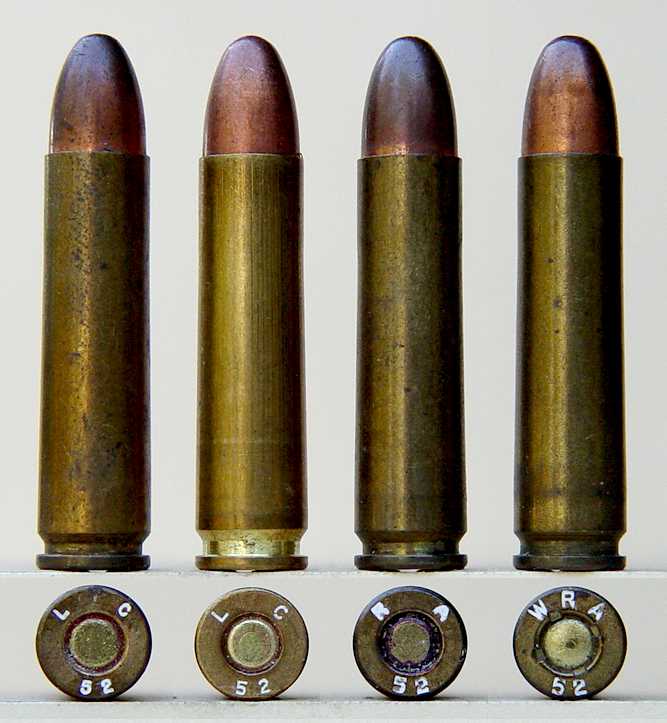 The
picture to the right shows four common .30 U.S. Carbine ball
loads, the headstamps indicating production by several American military and
contracted ammunition makers during the Korean War. While it appears I
goofed and included two cartridges made by the Lake City arsenal, this is
not the case. One of these is not
what it appears to be, having been made neither at the facility nor in the year
indicated by its headstamp. In fact, it wasn't even made in this country.
Though it closely resembles the real thing, the second cartridge from the
left is the impersonator. Note the similarity of its headstamp and flat
brass primer to the legitimate
Lake City cartridge on its right; the only apparent difference between it
and the other cartridges is its wider ejector groove. In addition to its
having a fraudulent headstamp, it is Berdan primed, though
this would only be evident when one looks into one of the
fired cases, or attempts to reload one. The story that came with this
box of cartridges was that it was made in China in the 1960s for use by the
communist forces in Vietnam; the reason The
picture to the right shows four common .30 U.S. Carbine ball
loads, the headstamps indicating production by several American military and
contracted ammunition makers during the Korean War. While it appears I
goofed and included two cartridges made by the Lake City arsenal, this is
not the case. One of these is not
what it appears to be, having been made neither at the facility nor in the year
indicated by its headstamp. In fact, it wasn't even made in this country.
Though it closely resembles the real thing, the second cartridge from the
left is the impersonator. Note the similarity of its headstamp and flat
brass primer to the legitimate
Lake City cartridge on its right; the only apparent difference between it
and the other cartridges is its wider ejector groove. In addition to its
having a fraudulent headstamp, it is Berdan primed, though
this would only be evident when one looks into one of the
fired cases, or attempts to reload one. The story that came with this
box of cartridges was that it was made in China in the 1960s for use by the
communist forces in Vietnam; the reason
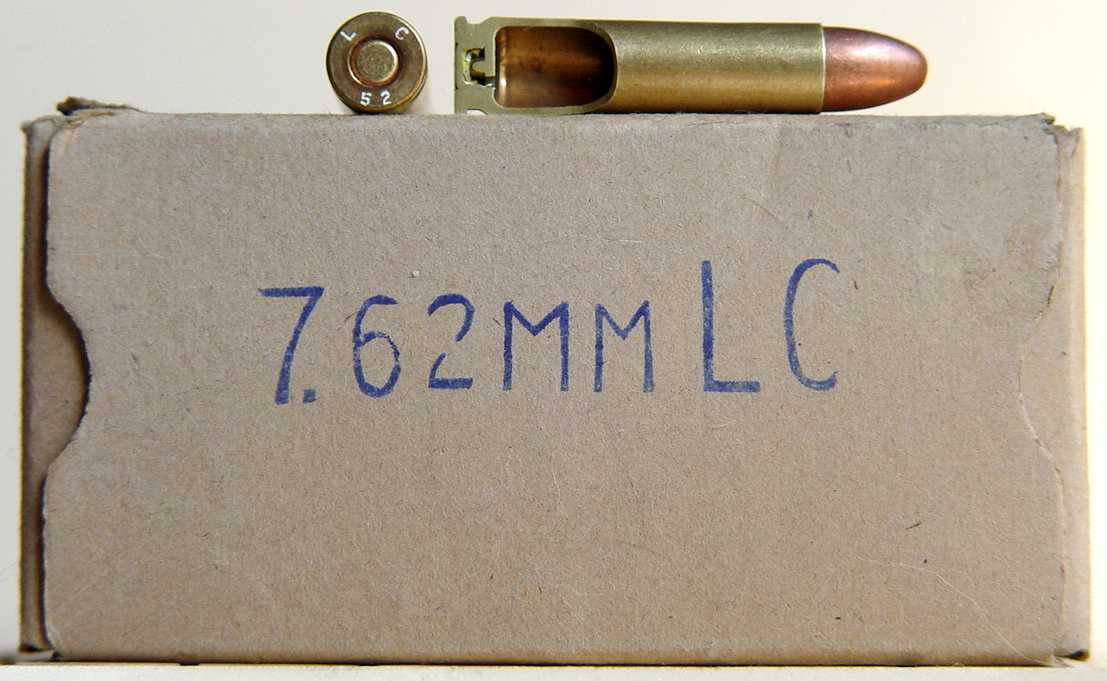 behind
the use of this particular headstamp is a mystery to me, but it most likely
was intended to cover up its origin. The generic box that this cartridge
came from is shown in the second picture. It holds 50, is of one
piece construction held together with staples, and has end flaps and a
slide-out tray. It is unmarked except for the top, which is stamped 7.62 MM
LC, the metric designation providing a good clue that the cartridges are not
all that they appear to be. The third picture is a close-up of the head of
the sectioned cartridge that is lying on the top of the box, and provides a
good view of the primer and the primer anvil, which is made integral with
the head. The case has two flash holes, one of which can also be seen in the
picture. Also note the apparent lack of a line in the metal defining the
outer edge of the primer cup from the case head. The primer cup
appears to have been cast in place, but if this were actually the case, it
would not be possible to get the priming compound in place. In an effort to
prepare one of the cartridges for photographing the primer pocket, I tried
several different a behind
the use of this particular headstamp is a mystery to me, but it most likely
was intended to cover up its origin. The generic box that this cartridge
came from is shown in the second picture. It holds 50, is of one
piece construction held together with staples, and has end flaps and a
slide-out tray. It is unmarked except for the top, which is stamped 7.62 MM
LC, the metric designation providing a good clue that the cartridges are not
all that they appear to be. The third picture is a close-up of the head of
the sectioned cartridge that is lying on the top of the box, and provides a
good view of the primer and the primer anvil, which is made integral with
the head. The case has two flash holes, one of which can also be seen in the
picture. Also note the apparent lack of a line in the metal defining the
outer edge of the primer cup from the case head. The primer cup
appears to have been cast in place, but if this were actually the case, it
would not be possible to get the priming compound in place. In an effort to
prepare one of the cartridges for photographing the primer pocket, I tried
several different a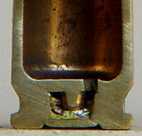 pproaches
to removing the primer, each a little more dangerous than the previous one
and all to no avail. In the interest of avoiding injuring myself, I finally
had to settle for sectioning the case. These primers are squeezed in so
tightly that I'm convinced there is no way to remove one without damaging
the case, and I hereby throw out the gauntlet to challenge anyone to try.
Once fired, there is no use for the empty cases, and they may as well be
trashed. On the other hand, due to the corrosive priming in these
cartridges, it may be a good idea to trash them before you shoot them. That
wide extractor groove should be a give-away to identifying them, but they
can also be identified by their lighter weight. I determined the average
weights of the complete cartridges, the bullets and the powder charges from
a sample of the Chinese cartridges and the US manufactured cartridges, which
revealed that the Chinese case (or, more accurately, the seemingly fused
case/primer combination) is significantly lighter than the US case. The
weights were as
follows : pproaches
to removing the primer, each a little more dangerous than the previous one
and all to no avail. In the interest of avoiding injuring myself, I finally
had to settle for sectioning the case. These primers are squeezed in so
tightly that I'm convinced there is no way to remove one without damaging
the case, and I hereby throw out the gauntlet to challenge anyone to try.
Once fired, there is no use for the empty cases, and they may as well be
trashed. On the other hand, due to the corrosive priming in these
cartridges, it may be a good idea to trash them before you shoot them. That
wide extractor groove should be a give-away to identifying them, but they
can also be identified by their lighter weight. I determined the average
weights of the complete cartridges, the bullets and the powder charges from
a sample of the Chinese cartridges and the US manufactured cartridges, which
revealed that the Chinese case (or, more accurately, the seemingly fused
case/primer combination) is significantly lighter than the US case. The
weights were as
follows :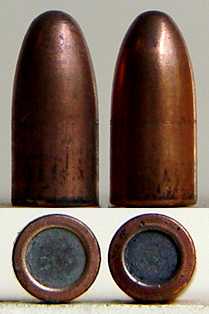
.
Complete cartridge:
Chinese - 188.0 grains
US - 192.0 grains
.
Bullet: (the Chinese bullet is on
the left side in this picture)
Chinese - 106.3 grains
US - 106.2 grains
.
Powder:
(the Chinese powder is on the left side of this picture)
Chinese - 13.0 grains
US - 12.9 grains
.
.
.
.
.
.
.
Improved 300 Magnum or Improved AMU?????
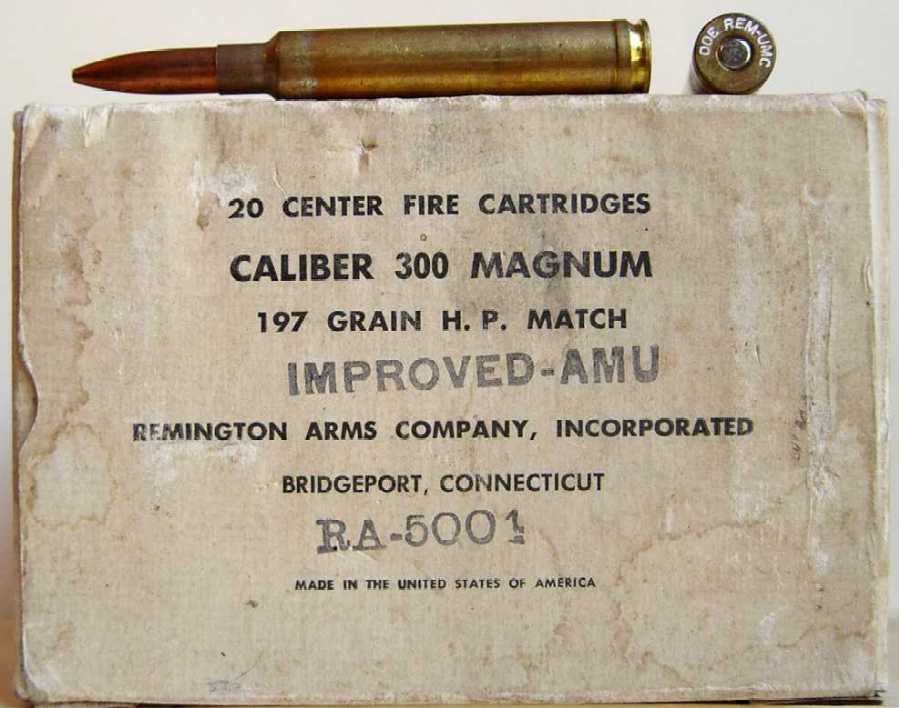 Here's
an item that I picked up on one of the internet auction sites, a full box of
Remington .300 Magnum Improved AMU. I have to assume that there is also a
.300 AMU out there that someone decided needed improving upon, but that
would just be a guess. I have to admit that I have absolutely no information
about this cartridge and, other than having seen one or two single examples
listed at outrageous prices on the internet recently, I had not heard of it
before. The price was quite reasonable, and I was able to add another
cartridge that I haven't a clue about to my growing collection, much to my
wife's dismay ("But you already have lots of cartridges. Why could you
possibly need more?"). The headstamp, the first on the left in the
picture below, is interesting, with the odd spacing indicating that the
bunter was likely made from an existing bunter for another caliber by
grinding off the lettering that was not wanted. A comparison of the the headstamps in Here's
an item that I picked up on one of the internet auction sites, a full box of
Remington .300 Magnum Improved AMU. I have to assume that there is also a
.300 AMU out there that someone decided needed improving upon, but that
would just be a guess. I have to admit that I have absolutely no information
about this cartridge and, other than having seen one or two single examples
listed at outrageous prices on the internet recently, I had not heard of it
before. The price was quite reasonable, and I was able to add another
cartridge that I haven't a clue about to my growing collection, much to my
wife's dismay ("But you already have lots of cartridges. Why could you
possibly need more?"). The headstamp, the first on the left in the
picture below, is interesting, with the odd spacing indicating that the
bunter was likely made from an existing bunter for another caliber by
grinding off the lettering that was not wanted. A comparison of the the headstamps in
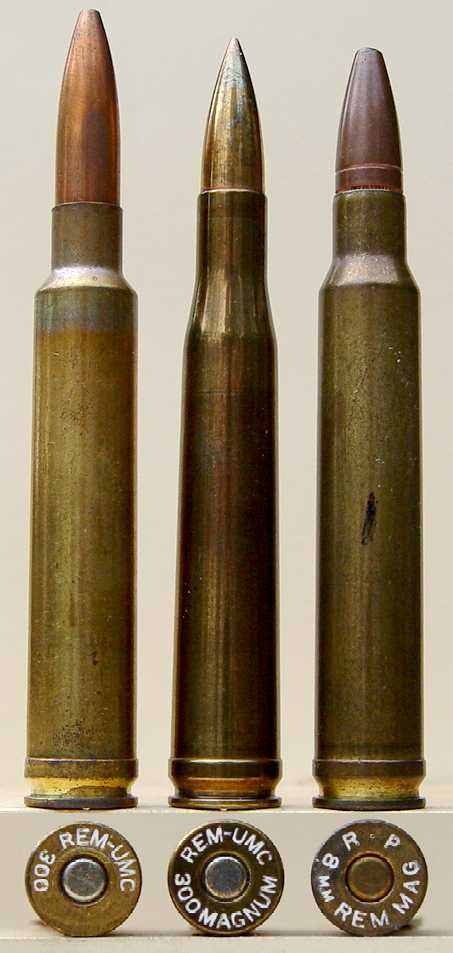 the
picture would suggest that a bunter for the .300 H&H Magnum (the headstamp
in the middle), would be a likely candidate for having been modified to
produce the .300 Improved AMU headstamp. the
picture would suggest that a bunter for the .300 H&H Magnum (the headstamp
in the middle), would be a likely candidate for having been modified to
produce the .300 Improved AMU headstamp.
The bullet in the .300 Improved AMU has a hollow point. The dimensions of the
case are:
bullet - .308"
neck - ..335"
shoulder - .485"
base (above the belt) - .507"
base (at the belt) - .525"
rim - .523
case length - 2.770"
overall length - 3.741"
These case dimensions closely
resemble the .300 Weatherby Magnum and the 8mm Remington Magnum, the third
cartridge in the picture.
I'd appreciate any information
that anyone could provide about the .300 Improved AMU.
.
.
.
.
.
.
More of those interesting .45-70
headstamps.....
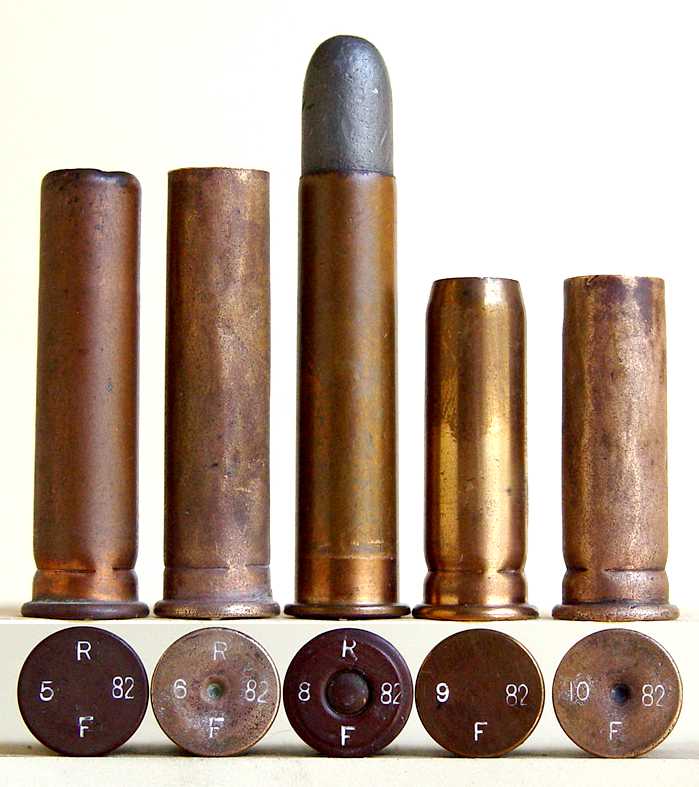
When first introduced, the .45-70 and .45-55 cartridges made at the
Frankford Arsenal used the Benet inside primer. Experimentation with
externally primed cases began in early 1877, first using the Berdan primer,
and later the Gill boxer-style primer. In 1882, the decision was made to
adopt the externally primed case as the standard. Production of Benet primed
cases was suspended in June or July of 1882 to allow the necessary equipment
changes to be made. Production of the new cases began in August. The
cartridges in this picture were all made around this transition period. The
first two are examples from the last months of standard production of Benet-primed
cases at the arsenal. The first one, produced in May of 1882, was originally
a ball load, as evidenced by its 4 character headstamp and its 2.1" length,
but apparently was rejected or condemned, and was converted to a blank by pulling the bullet
and crimping the case mouth. The insides of the case mouths on these will
usually have a green residue produced by a reaction between the copper and
the bullet lubricant. The second, made in June, is a fired ball load. I
don't have a Benet-primed example made in July, and suspect that there was
no production at all during that month; if I'm incorrect, I'd appreciate it if
someone who has one would let me know and send me a picture. The third
cartridge has an external primer, and was made in August, the first month of standard
production. The last two cartridges are blanks, having been originally made
as such based on their three character headstamps and their shorter lengths.
Note that these two are Benet-primed, but have headstamps indicating
production in September and October of 1882. Apparently, the production
lines for blank cartridges continued to utilize and headstamp Benet-primed
cases after production of the externally primed cases began, probably as a
means of using up the inside-primed cases on hand. I have none of
these inside primed blanks made after October of 1882, nor do I have any externally primed blanks
made prior to1883
.
.
.
.
|

 The
picture to the right shows four common .30 U.S. Carbine ball
loads, the headstamps indicating production by several American military and
contracted ammunition makers during the Korean War. While it appears I
goofed and included two cartridges made by the Lake City arsenal, this is
not the case. One of these is not
what it appears to be, having been made neither at the facility nor in the year
indicated by its headstamp. In fact, it wasn't even made in this country.
Though it closely resembles the real thing, the second cartridge from the
left is the impersonator. Note the similarity of its headstamp and flat
brass primer to the legitimate
Lake City cartridge on its right; the only apparent difference between it
and the other cartridges is its wider ejector groove. In addition to its
having a fraudulent headstamp, it is Berdan primed, though
this would only be evident when one looks into one of the
fired cases, or attempts to reload one. The story that came with this
box of cartridges was that it was made in China in the 1960s for use by the
communist forces in Vietnam; the reason
The
picture to the right shows four common .30 U.S. Carbine ball
loads, the headstamps indicating production by several American military and
contracted ammunition makers during the Korean War. While it appears I
goofed and included two cartridges made by the Lake City arsenal, this is
not the case. One of these is not
what it appears to be, having been made neither at the facility nor in the year
indicated by its headstamp. In fact, it wasn't even made in this country.
Though it closely resembles the real thing, the second cartridge from the
left is the impersonator. Note the similarity of its headstamp and flat
brass primer to the legitimate
Lake City cartridge on its right; the only apparent difference between it
and the other cartridges is its wider ejector groove. In addition to its
having a fraudulent headstamp, it is Berdan primed, though
this would only be evident when one looks into one of the
fired cases, or attempts to reload one. The story that came with this
box of cartridges was that it was made in China in the 1960s for use by the
communist forces in Vietnam; the reason
 behind
the use of this particular headstamp is a mystery to me, but it most likely
was intended to cover up its origin. The generic box that this cartridge
came from is shown in the second picture. It holds 50, is of one
piece construction held together with staples, and has end flaps and a
slide-out tray. It is unmarked except for the top, which is stamped 7.62 MM
LC, the metric designation providing a good clue that the cartridges are not
all that they appear to be. The third picture is a close-up of the head of
the sectioned cartridge that is lying on the top of the box, and provides a
good view of the primer and the primer anvil, which is made integral with
the head. The case has two flash holes, one of which can also be seen in the
picture. Also note the apparent lack of a line in the metal defining the
outer edge of the primer cup from the case head. The primer cup
appears to have been cast in place, but if this were actually the case, it
would not be possible to get the priming compound in place. In an effort to
prepare one of the cartridges for photographing the primer pocket, I tried
several different a
behind
the use of this particular headstamp is a mystery to me, but it most likely
was intended to cover up its origin. The generic box that this cartridge
came from is shown in the second picture. It holds 50, is of one
piece construction held together with staples, and has end flaps and a
slide-out tray. It is unmarked except for the top, which is stamped 7.62 MM
LC, the metric designation providing a good clue that the cartridges are not
all that they appear to be. The third picture is a close-up of the head of
the sectioned cartridge that is lying on the top of the box, and provides a
good view of the primer and the primer anvil, which is made integral with
the head. The case has two flash holes, one of which can also be seen in the
picture. Also note the apparent lack of a line in the metal defining the
outer edge of the primer cup from the case head. The primer cup
appears to have been cast in place, but if this were actually the case, it
would not be possible to get the priming compound in place. In an effort to
prepare one of the cartridges for photographing the primer pocket, I tried
several different a pproaches
to removing the primer, each a little more dangerous than the previous one
and all to no avail. In the interest of avoiding injuring myself, I finally
had to settle for sectioning the case. These primers are squeezed in so
tightly that I'm convinced there is no way to remove one without damaging
the case, and I hereby throw out the gauntlet to challenge anyone to try.
Once fired, there is no use for the empty cases, and they may as well be
trashed. On the other hand, due to the corrosive priming in these
cartridges, it may be a good idea to trash them before you shoot them. That
wide extractor groove should be a give-away to identifying them, but they
can also be identified by their lighter weight. I determined the average
weights of the complete cartridges, the bullets and the powder charges from
a sample of the Chinese cartridges and the US manufactured cartridges, which
revealed that the Chinese case (or, more accurately, the seemingly fused
case/primer combination) is significantly lighter than the US case. The
weights were as
follows :
pproaches
to removing the primer, each a little more dangerous than the previous one
and all to no avail. In the interest of avoiding injuring myself, I finally
had to settle for sectioning the case. These primers are squeezed in so
tightly that I'm convinced there is no way to remove one without damaging
the case, and I hereby throw out the gauntlet to challenge anyone to try.
Once fired, there is no use for the empty cases, and they may as well be
trashed. On the other hand, due to the corrosive priming in these
cartridges, it may be a good idea to trash them before you shoot them. That
wide extractor groove should be a give-away to identifying them, but they
can also be identified by their lighter weight. I determined the average
weights of the complete cartridges, the bullets and the powder charges from
a sample of the Chinese cartridges and the US manufactured cartridges, which
revealed that the Chinese case (or, more accurately, the seemingly fused
case/primer combination) is significantly lighter than the US case. The
weights were as
follows :

 Here's
an item that I picked up on one of the internet auction sites, a full box of
Remington .300 Magnum Improved AMU. I have to assume that there is also a
.300 AMU out there that someone decided needed improving upon, but that
would just be a guess. I have to admit that I have absolutely no information
about this cartridge and, other than having seen one or two single examples
listed at outrageous prices on the internet recently, I had not heard of it
before. The price was quite reasonable, and I was able to add another
cartridge that I haven't a clue about to my growing collection, much to my
wife's dismay ("But you already have lots of cartridges. Why could you
possibly need more?"). The headstamp, the first on the left in the
picture below, is interesting, with the odd spacing indicating that the
bunter was likely made from an existing bunter for another caliber by
grinding off the lettering that was not wanted. A comparison of the the headstamps in
Here's
an item that I picked up on one of the internet auction sites, a full box of
Remington .300 Magnum Improved AMU. I have to assume that there is also a
.300 AMU out there that someone decided needed improving upon, but that
would just be a guess. I have to admit that I have absolutely no information
about this cartridge and, other than having seen one or two single examples
listed at outrageous prices on the internet recently, I had not heard of it
before. The price was quite reasonable, and I was able to add another
cartridge that I haven't a clue about to my growing collection, much to my
wife's dismay ("But you already have lots of cartridges. Why could you
possibly need more?"). The headstamp, the first on the left in the
picture below, is interesting, with the odd spacing indicating that the
bunter was likely made from an existing bunter for another caliber by
grinding off the lettering that was not wanted. A comparison of the the headstamps in
 the
picture would suggest that a bunter for the .300 H&H Magnum (the headstamp
in the middle), would be a likely candidate for having been modified to
produce the .300 Improved AMU headstamp.
the
picture would suggest that a bunter for the .300 H&H Magnum (the headstamp
in the middle), would be a likely candidate for having been modified to
produce the .300 Improved AMU headstamp. 